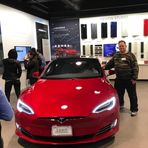Ford and GM: Navigating the Electric Frontier
October 23, 2024, 4:44 am

Location: United States, Michigan, Ypsilanti
Employees: 10001+
Founded date: 1896
Total raised: $40K

Location: United States, Texas, Austin
Employees: 10001+
Founded date: 2003
Total raised: $3.86B
The automotive landscape is shifting. Ford and General Motors (GM) are at the forefront of this transformation. Both companies are wrestling with the challenges and opportunities presented by electric vehicles (EVs). Their recent actions reveal a lot about their strategies and the current state of the market.
Ford recently advised some of its electric vehicle customers to stop using Tesla Supercharger adapters. This comes after the company identified a potential issue that could affect charging speeds and even damage the charging ports. The irony is palpable. Ford, once a pioneer in the gas-powered era, is now navigating the electric currents of the future. They initially offered free adapters to Tesla’s network, but now they’re backtracking. It’s a reminder that in the EV world, the ground can shift beneath your feet.
The company is taking steps to rectify the situation. They will provide new adapters at no cost, along with instructions for returning the problematic ones. This proactive approach is commendable. However, it raises questions about quality control and the reliability of new technologies. Rivian and GM have reported no such issues with their adapters, highlighting Ford's unique predicament.
Meanwhile, GM is riding a wave of success. Their recent earnings report exceeded Wall Street expectations, with shares surging to their highest levels since February 2022. The company reported an adjusted earnings per share of $2.96, surpassing estimates of $2.43. This surge is largely attributed to resilient consumer demand for their trucks and SUVs. The market is responding positively, with GM’s stock climbing 36% this year. It’s a stark contrast to Ford, which has struggled with quality issues and declining sales.
GM’s CFO expressed optimism about the future. He noted that consumer demand remains strong, and as financing rates decrease, sales are expected to improve. This confidence is crucial in an industry facing economic headwinds. GM is also restructuring its operations in China, where it has faced significant losses. The company lost $137 million in the third quarter alone. Yet, despite these challenges, GM is poised to deliver between $14 billion and $15 billion in pretax profit for 2024. This is a beacon of hope amid uncertainty.
The EV market is a double-edged sword. While it offers immense potential, it also presents significant risks. Both Ford and GM are investing heavily in electric technology. However, the transition is fraught with challenges. GM’s EV sales have increased, but they still account for only about 4% of total U.S. deliveries. The competition is fierce, especially from Chinese manufacturers that are producing affordable electric vehicles. The pressure is mounting.
Ford’s recent troubles with Tesla adapters are a reminder of the complexities involved in this transition. The EV landscape is still evolving. Consumers are becoming more discerning. They want reliability and performance. Ford’s misstep could tarnish its reputation, especially as it tries to establish itself in the electric market.
On the other hand, GM is focusing on stability. CEO Mary Barra has emphasized that the company’s profit next year is expected to mirror this year’s results. This cautious approach is wise. The automotive industry is notorious for its volatility. GM’s strategy includes cost cuts on SUVs and EVs, which could help maintain profitability amid softer pricing.
Both companies are aware of the looming threat from low-cost competitors. Tesla continues to dominate the EV market, and its influence is undeniable. Ford and GM must innovate and adapt quickly. The race is on to develop profitable electric vehicles. GM has committed to producing EVs that can turn a profit, a crucial step in securing its future.
The autonomous vehicle sector adds another layer of complexity. GM’s Cruise unit has faced scrutiny after a high-profile incident involving a pedestrian. The unit reported an operating loss of $400 million, but this was an improvement from the previous year. Investors are eager for clarity on this front. The future of autonomous vehicles remains uncertain, but the potential rewards are immense.
In conclusion, Ford and GM are navigating a rapidly changing automotive landscape. Ford’s recent adapter issue highlights the challenges of transitioning to electric vehicles. Meanwhile, GM is riding a wave of success, buoyed by strong consumer demand. Both companies are investing heavily in the future, but the road ahead is fraught with obstacles. The electric vehicle revolution is here, and only the most adaptable will thrive. The stakes are high, and the competition is fierce. The automotive giants must innovate, learn from their missteps, and stay ahead of the curve. The future of transportation hangs in the balance.
Ford recently advised some of its electric vehicle customers to stop using Tesla Supercharger adapters. This comes after the company identified a potential issue that could affect charging speeds and even damage the charging ports. The irony is palpable. Ford, once a pioneer in the gas-powered era, is now navigating the electric currents of the future. They initially offered free adapters to Tesla’s network, but now they’re backtracking. It’s a reminder that in the EV world, the ground can shift beneath your feet.
The company is taking steps to rectify the situation. They will provide new adapters at no cost, along with instructions for returning the problematic ones. This proactive approach is commendable. However, it raises questions about quality control and the reliability of new technologies. Rivian and GM have reported no such issues with their adapters, highlighting Ford's unique predicament.
Meanwhile, GM is riding a wave of success. Their recent earnings report exceeded Wall Street expectations, with shares surging to their highest levels since February 2022. The company reported an adjusted earnings per share of $2.96, surpassing estimates of $2.43. This surge is largely attributed to resilient consumer demand for their trucks and SUVs. The market is responding positively, with GM’s stock climbing 36% this year. It’s a stark contrast to Ford, which has struggled with quality issues and declining sales.
GM’s CFO expressed optimism about the future. He noted that consumer demand remains strong, and as financing rates decrease, sales are expected to improve. This confidence is crucial in an industry facing economic headwinds. GM is also restructuring its operations in China, where it has faced significant losses. The company lost $137 million in the third quarter alone. Yet, despite these challenges, GM is poised to deliver between $14 billion and $15 billion in pretax profit for 2024. This is a beacon of hope amid uncertainty.
The EV market is a double-edged sword. While it offers immense potential, it also presents significant risks. Both Ford and GM are investing heavily in electric technology. However, the transition is fraught with challenges. GM’s EV sales have increased, but they still account for only about 4% of total U.S. deliveries. The competition is fierce, especially from Chinese manufacturers that are producing affordable electric vehicles. The pressure is mounting.
Ford’s recent troubles with Tesla adapters are a reminder of the complexities involved in this transition. The EV landscape is still evolving. Consumers are becoming more discerning. They want reliability and performance. Ford’s misstep could tarnish its reputation, especially as it tries to establish itself in the electric market.
On the other hand, GM is focusing on stability. CEO Mary Barra has emphasized that the company’s profit next year is expected to mirror this year’s results. This cautious approach is wise. The automotive industry is notorious for its volatility. GM’s strategy includes cost cuts on SUVs and EVs, which could help maintain profitability amid softer pricing.
Both companies are aware of the looming threat from low-cost competitors. Tesla continues to dominate the EV market, and its influence is undeniable. Ford and GM must innovate and adapt quickly. The race is on to develop profitable electric vehicles. GM has committed to producing EVs that can turn a profit, a crucial step in securing its future.
The autonomous vehicle sector adds another layer of complexity. GM’s Cruise unit has faced scrutiny after a high-profile incident involving a pedestrian. The unit reported an operating loss of $400 million, but this was an improvement from the previous year. Investors are eager for clarity on this front. The future of autonomous vehicles remains uncertain, but the potential rewards are immense.
In conclusion, Ford and GM are navigating a rapidly changing automotive landscape. Ford’s recent adapter issue highlights the challenges of transitioning to electric vehicles. Meanwhile, GM is riding a wave of success, buoyed by strong consumer demand. Both companies are investing heavily in the future, but the road ahead is fraught with obstacles. The electric vehicle revolution is here, and only the most adaptable will thrive. The stakes are high, and the competition is fierce. The automotive giants must innovate, learn from their missteps, and stay ahead of the curve. The future of transportation hangs in the balance.
